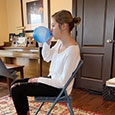Playing the flute requires an asymmetrical stance and balancing position, but there are activities that can mitigate that lopsidedness so that breathing is freer, and the body does not get in the way of a great performance. People are roughly symmetrical on the outside (two arms, two legs, two eyes, etc.), but there are many internal asymmetries that have a profound effect upon the way we subconsciously stand, move, and breathe. The heart is on the left; the right lung has three lobes; the left one has only two; the right half of the diaphragm is larger than the left; the liver is on the right; and so on.
Flutists tend to stand on the right leg with the left hip dropped and the left leg rotated outward. The right side of the thorax is bent to the right, limiting rib movement. There are many more differences, but just imagine Michelangelo’s statue of David to get a general idea. One way to offset these tendencies is to turn off some muscles and turn on others. The goal is to create a natural and even subconscious way of using the body symmetrically. The following techniques are physical and relatively easy to do. Add them to your practice sessions now to be in tiptop shape for upcoming performances this spring.
Shifting Weight
While you are playing, shift your weight back and forth while standing or sitting. Move from the left foot to the right, or if sitting, from the right ischial tuberosity (sits bone) to the left. This back-and-forth movement breaks up muscular tension, allowing your ribs and thorax to move more easily during the quick inspirations and long slow exhalations required by flute playing.
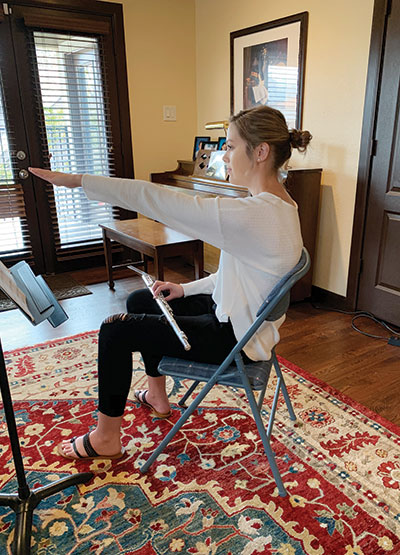
Reaching
Reaching forward helps to open the back between and below the shoulder blades, an area especially important in expansion of the ribs and the spaces outside of them. While sitting in a chair, take a breath in through your nose and then slowly exhale while you reach forward with your left arm. Keep the left side of your back against the back of the chair. Pause for three seconds and then inhale through your nose again and try to reach a little further as you exhale out. Repeat for a total of four times. Continue on with your practicing and see if breathing seems easier.
Blowing Up a Balloon
This activity is an amazing way to promote optimal posture and neuromuscular control of the deep abdominals, diaphragm, and pelvic floor. As you sit in a chair, bend to the left side so that you are leaning on the armrest (if there is one). Inhale through your nose and gently and slowly, partially exhale into the balloon. Pause three seconds with the tongue on the roof of the mouth to prevent airflow out of the balloon.
Without pinching the neck of the balloon and while keeping the tongue on the roof of the mouth, inhale again through the nose. Slowly blow out again into the balloon. Repeat four times. Then pinch the balloon neck, remove it from your mouth and let the air out. See if your breath control feels better now during playing. (It is okay to cheat and pinch off the balloon between breaths if you have to.)

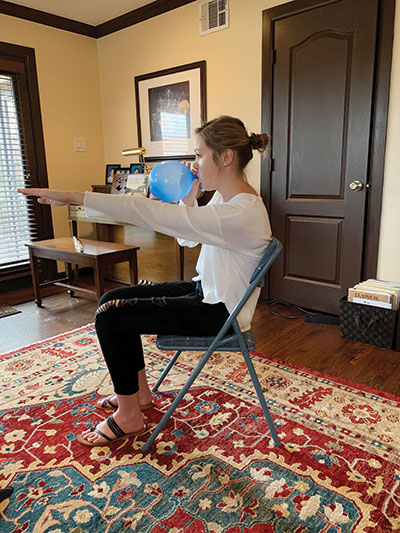
Reaching while blowing up a balloon
Bow and Arrow
Assume a position as if you are shooting an imaginary bow and arrow with the right arm reaching forward (as if holding the bow) and the left arm back (as if pulling string and holding arrow). This is the opposite position to holding a flute. The left leg should be in front with your weight on it, and your right hip should be forward. Use the same breathing techniques as explained in reaching. Returning to your regular flute stance should feel freer and easier and your breathing deeper.
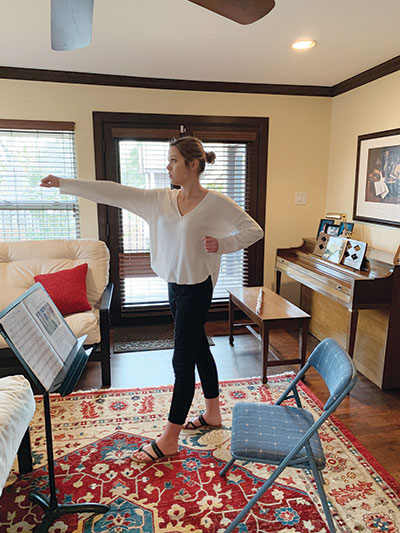
Left Front Lower Ribs
Because of the asymmetrical set-up of the thorax, rib depression of the left front lower ribcage is limited. An easy way to get this area of the ribcage to move further down and in during exhalation is to simple place your hands over that area and assist the ribs to move down and in as you exhale through the mouth fully. Curve your spine forward as you slowly exhale. Pause three seconds and then inhale through the nose and then exhale again as you push more with your hands and curl downward even more. Repeat for a total of four times and then slowly return to an upright position. Do the whole thing for a total of four to five times. Getting the left front lower ribs to do a more effective job during exhalation puts the left side of the diaphragm into a more curved position to match that of the right side, allowing you a longer more controlled exhale. When playing on a long exhale, this is an important movement to emphasize.
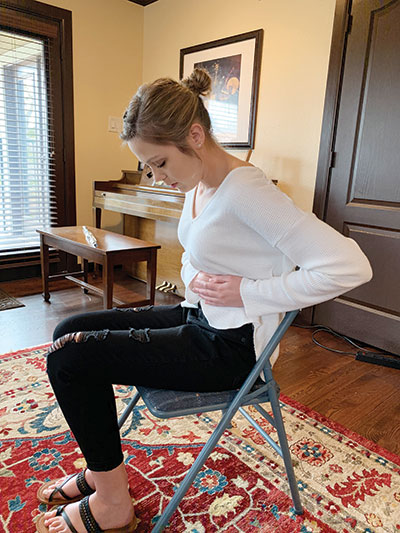
Left Foot Focus
Push your left heel and arch into the floor as you play, whether sitting or standing. This sparks the facilitation of a chain of muscles on the left side that goes up to the left diaphragm and helps it get into the best position for proper breathing. Note that this would be harder to accomplish in high heel shoes. Just thinking about it momentarily while you are playing will improve your breathing. This is why everyone is told to play with both feet on the floor.
Tongue Reaches
This simple workout is a great plug-in when you need a short break from practicing. The beauty of it is that it increases the awareness of where your tongue is and how it moves. Repeat the following three exercises five times each. First, move the tip of your tongue toward your nose and then toward your chin. Next, touch each of the lower back molars, going back and forth between right and left. Repeat this but touching the upper back molars instead of the lower ones. As a reminder, the resting position for the tongue is on the roof of your mouth.
Play Long-Sitting
Long-sitting is sitting on the floor with your legs out straight in front of you. This position gives you the opportunity to feel your left back against the wall and work on improving its expansion. You can do the reaching technique, blowing up a balloon, or play your flute in this position. When playing the flute, be sure that your head is turned to the left about 45 degrees and that the right end of the flute angles away from the wall.
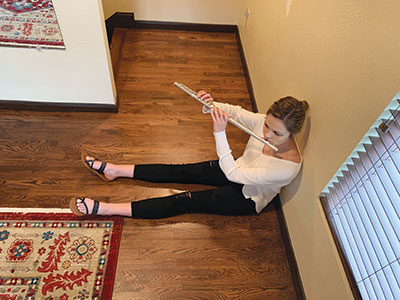
Left Stance
Sing, recite poetry, cook, and practice in left stance. This is not to say that you should stand only on the left, but rather to try to stand on your left leg more than you would have otherwise. Feel the left arch and heel as they come into contact with floor. The goal of this left focus is to get you to do this automatically. This will spill over into your flute playing, freeing up breathing and reducing tension.
Take a Hike
Go for a walk and focus on the reciprocal motion (the back and forth repetitive movement) of your arms. Try to have nothing in your hands (like a phone) so you can focus on a full and even arm swing. You should feel your thorax rotate as well even though it is a more subtle movement. Walking, as with any other form of aerobic exercise, should be included as part of the practice routine.
Squatting
Sitting is actually a passive squat and is not a natural position for human beings. Anyone can do a real squat; it is not just for weightlifters. By adding a breathing component, you get more bang for your buck. It is a strengthening exercise for the body and a breathing exercise for flute playing. To begin, keep your feet shoulder width apart and pointed straight ahead. Arms are straight out ahead for balance. Round out your back as you tuck your bottom under you. Keep your weight through your heels as you lower your body down as far as you are able without losing balance. Hold for four to five deep breaths in through the nose and out through the mouth. Attempt to fill or expand the upper back chest wall with air on each inhalation. On the final exhale, slowly stand up by pushing through your heels and keeping your back rounded. Relax and repeat four more times. Pick up your flute again and see how you sound.
Change It Up
Cross the opposite arm or leg than you usually do. Sleep on the opposite side of the bed or on your opposite side. Watch TV from the other side of the room. Sit in a different place in the classroom or at church. Hold the book you are reading in the hand that feels more awkward. Sit on the opposite side of the bus or subway than you usually do. All of these things will help wake up your body to symmetry, making you more physically balanced.
Monkey Bars
Hang from a bar and let your shoulders stretch out evenly. Be careful not to hurt yourself; this is not a good exercise if you have shoulder problems. If using a bar indoors such as the spring bar kind that you can put in a door well, gradually increase the percentage of your weight that you let hang. Thirty seconds is a good time to aim for. If you are on the younger side or have students who are, go to a park with monkey bars, and make it a habit to go down and back on them. It is great for stretching, strengthening, mitigating the effects of gravity, and emphasizing alternating, reciprocal motion. It is beneficial to get out of the standard position for holding the flute and teach the body to easily shift from left to right and back again.
As always, if you have not exercised lately, check with your doctor first to make sure it is okay. These exercises are intended for asymptomatic individuals. If you have any shoulder limitations, take extra care. These movements should not cause pain. A little soreness the next day is okay, but if it is not gone by the third day, you did too much and should back off.
The bulk of these ideas came from my studies with The Postural Restoration Institute, an astute group of physical therapists dedicated to investigating and understanding the neuromuscular mechanisms of the human body as it moves. More information can be found at www.posturalrestoration.com.
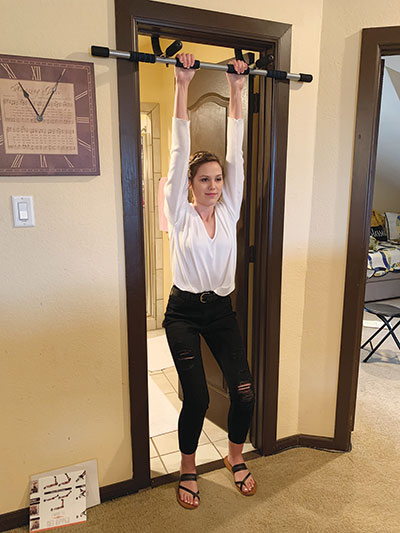
Thanks to TCU flutist Becca Carter for demonstrating the exercises in the photo illustrations.
